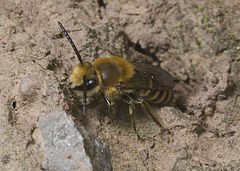
Bees are winged insects closely related to wasps and ants, known for their roles in pollination and, in the case of the best-known bee species, the western honey bee, for producing honey. Bees are a monophyletic lineage within the superfamily Apoidea. They are currently considered a clade, called Anthophila. There are over 20,000 known species of bees in seven recognized biological families. Some species – including honey bees, bumblebees, and stingless bees – live socially in colonies while most species (>90%) – including mason bees, carpenter bees, leafcutter bees, and sweat bees – are solitary.
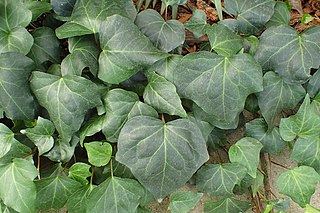
Hedera, commonly called ivy, is a genus of 12–15 species of evergreen climbing or ground-creeping woody plants in the family Araliaceae, native to Western Europe, Central Europe, Southern Europe, Macaronesia, northwestern Africa and across central-southern Asia east to Japan and Taiwan. Several species are cultivated as climbing ornamentals, and the name ivy especially denotes the commonly grown English ivy, which is frequently planted to clothe brick walls.

The Colletidae are a family of bees, and are often referred to collectively as plasterer bees or polyester bees, due to the method of smoothing the walls of their nest cells with secretions applied with their mouthparts; these secretions dry into a cellophane-like lining. The five subfamilies, 54 genera, and over 2000 species are all evidently solitary, though many nest in aggregations. Two of the subfamilies, Euryglossinae and Hylaeinae, lack the external pollen-carrying apparatus that otherwise characterizes most bees, and instead carry the pollen in their crops. These groups, and most genera in this family, have liquid or semiliquid pollen masses on which the larvae develop.

Habropoda laboriosa, the southeastern blueberry bee, is a bee in the family Apidae. It is native to the eastern United States. It is regarded as the most efficient pollinator of southern rabbiteye blueberries, because the flowers require buzz pollination, and H. laboriosa is one of the few bees that exhibit this behavior. It is active for only a few weeks of the year, while the blueberries are in flower during early spring, when the temperature is warm and humid. H. laboriosa are solitary bees that live alone but nest in close proximity with other nests of their species. They have similar features to bumble bees, but they are smaller in size compared to them. H. laboriosa are arthropods so they have segmented bodies that are composed of the head, thorax, and abdomen.

The genus Colletes is a large group of ground-nesting bees of the family Colletidae. They occur primarily in the Northern Hemisphere. They tend to be solitary, but sometimes nest close together in aggregations. Species in the genus build cells in underground nests that are lined with a cellophane-like plastic secretion, a true polyester, earning them the nickname polyester bees.

Osmia bicornis is a species of mason bee, and is known as the red mason bee due to its covering of dense gingery hair. It is a solitary bee that nests in holes or stems and is polylectic, meaning it forages pollen from various different flowering plants. These bees can be seen aggregating together and nests in preexisting hollows, choosing not to excavate their own. These bees are not aggressive; they will only sting if handled very roughly and are safe to be closely observed by children. Females only mate once, usually with closely related males. Further, females can determine the sex ratio of their offspring based on their body size, where larger females will invest more in diploid females eggs than small bees. These bees also have trichromatic colour vision and are important pollinators in agriculture.

Andrena agilissima is a species of mining bee. They are present in most of Europe, the Near East and North Africa and can be found from April through July. Andrena agilissima is an oligolectic species, feeding only on the pollen of a few genera of Cruciferous vegetables.

Anthidium maculosum is a species of bee in the family Megachilidae, the leaf-cutter, carder, or mason bees. It is a solitary bee where the males are territorial and the females take part in polyandry. The males of A. maculosum differ from most other males of bee species because the males are significantly larger than females. In addition, subordinate males that act as satellites are smaller than territory-owning males. This species can be found predominately in Mexico and the United States.

Ptilothrix is a genus within the tribe Emphorini of the family Apidae. Bees of this genus can range from 7 to 15 mm. Ptilothrix species are solitary, ground-nesting bees. These bees have especially prominent hairs in the scopae of their hind legs, to help gather pollen to provision their nests. Ptilothrix species specialize on certain families of plants for their pollen, including the families Malvaceae, Convolvulaceae, Onagraceae, Cactaceae, Pontederiaceae, and Asteraceae. The genus is found in the New World, with species ranging across the Americas.

The Oriental carpenter bee, Xylocopa nasalis, or Xylocopa (Biluna) nasalis, is a species of carpenter bee. It is widely distributed in Southeast Asian countries. It is a major pollinator within its ecosystem, and is often mistaken for a bumblebee. The species leads a solitary lifestyle with a highly female-biased colony in the nest.
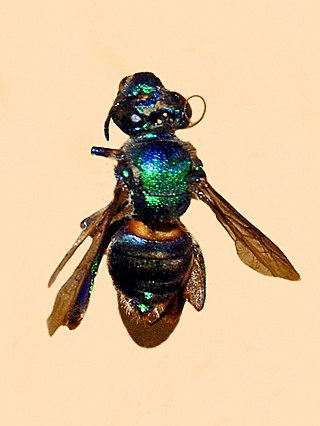
Euglossa cordata is a primitively eusocial orchid bee of the American tropics. The species is known for its green body color and ability to fly distances of over 50 km. Males mostly disperse and leave their home nests, while females have been observed to possess philopatric behavior. Because of this, sightings are rare and little is known about the species. However, it has been observed that adults who pollinate certain species of orchids will become intoxicated during the pollination.

Eufriesea surinamensis belongs to the tribe of euglossine bees and as such is a species of orchid bee. This should not be mistaken with the species group surinamensis, which includes Ef. surinamensis among other Eufriesea species.
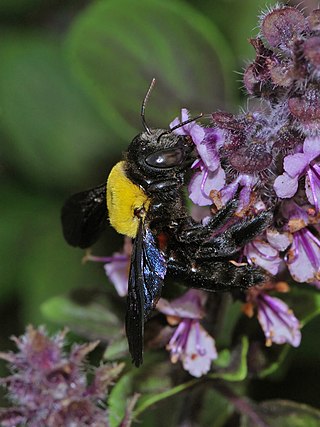
Xylocopa pubescens is a species of large carpenter bee. Females form nests by excavation with their mandibles, often in dead or soft wood. X. pubescens is commonly found in areas extending from India to Northeast and West Africa. It must reside in these warm climates because it requires a minimum ambient temperature of 18 °C (64 °F) in order to forage.

Macropis nuda is a ground nesting, univoltine bee native to northern parts of North America. Thus, this species cocoons as pupae and hibernates over the winter. The species is unusual as it is an oligolectic bee, foraging exclusively for floral oils and pollen from Primulaceae of the species Lysimachia ciliata.

Colletes halophilus, the sea aster mining bee, is a rare species of mining bee from the family Colletidae which is found around the margins of saltmarsh and other coastal habitats in south-eastern England and north-western Europe. It is threatened by rising sea levels and human development which reduce its food plant sea aster and destroy its nesting areas.

Colletes succinctus, the common colletes or heather colletes, is a species of Palearctic mining bee from the family Colletidae. It is part of the succinctus species group within the genus Colletes and is especially closely related to the ivy bee and the sea aster mining bee which are partially sympatric with C. succinctus but ecologically separate.
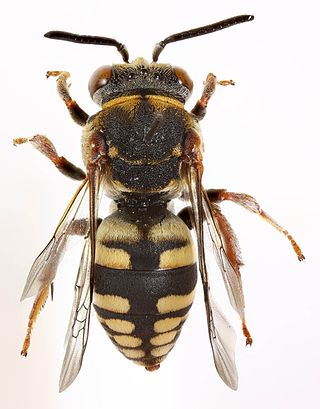
Epeolus cruciger, the red-thighed epeolus, is a species of cuckoo bee from the family Apidae. It is endemic to Europe, where its main host is the common colletes, although other species of Colletes mining bees have been recorded as hosts.

Stenoria analis, the ivy bee blister beetle, is a species of blister beetle from the family Meloidae which is found in western Europe and North Africa and is a specialist cleptoparasite of the ivy bee larvae. Its occurrence in regions outside of the known range of the ivy bee, for example in North Africa, suggest that it has other hosts.

Colletes validus, colloquially known as the blueberry cellophane bee, is a solitary, specialist bee in the family Colletidae. It is found primarily in eastern North America where it nests in sandy soils near ericaceous plants.

Centris analis is a solitary, oil-collecting bee with a geographical range extending from Brazil to Mexico. C. analis is a small, fast-flying bee with an average head width of 3.21mm and 3.54mm for males and females, respectively. While most species of the genus Centris create burrows for nesting, C. analis and other species of the subgenus Heterocentris build nests in pre-existing cavities rather than in the ground. C. analis is a pollinator of many plant species, especially of those in the family Malpighiaceae, which has encouraged its application in acerola orchards.



